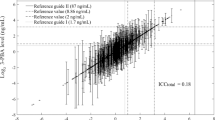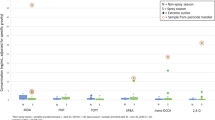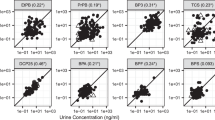Abstract
To determine the major factors affecting the urinary levels of 2,4-dichlorophenoxyacetic acid (2,4-D) among county noxious weed applicators in Kansas, we used a regression technique that accounted for multiple days of exposure. We collected 136 12-h urine samples from 31 applicators during the course of two spraying seasons (April to August of 1994 and 1995). Using mixed-effects models, we constructed exposure models that related urinary 2,4-D measurements to weighted self-reported work activities from daily diaries collected over 5 to 7 days before the collection of the urine sample. Our primary weights were based on an earlier pharmacokinetic analysis of turf applicators; however, we examined a series of alternative weighting schemes to assess the impact of the specific weights and the number of days before urine sample collection that were considered. The derived models accounting for multiple days of exposure related to a single urine measurement seemed robust with regard to the exact weights, but less to the number of days considered; albeit the determinants from the primary model could be fitted with marginal losses of fit to the data from the other weighting schemes that considered a different numbers of days. In the primary model, the total time of all activities (spraying, mixing, other activities), spraying method, month of observation, application concentration, and wet gloves were significant determinants of urinary 2,4-D concentration and explained 16% of the between-worker variance and 23% of the within-worker variance of urinary 2,4-D levels. As a large proportion of the variance remained unexplained, further studies should be conducted to try to systematically assess other exposure determinants.
This is a preview of subscription content, access via your institution
Access options
Subscribe to this journal
Receive 6 print issues and online access
$259.00 per year
only $43.17 per issue
Buy this article
- Purchase on Springer Link
- Instant access to full article PDF
Prices may be subject to local taxes which are calculated during checkout
Similar content being viewed by others
Abbreviations
- 2,4-D, 2:
-
4-dichlorophenoxyacetic acid
References
Alexander B.H., Mandel J.S., Baker B.A., Burns C.J., Bartels M.J., Acquavella J.F., and Gustin C. Biomonitoring of 2,4-dichlorophenoxyacetic acid exposure and dose in farm families. Environ Health Perspect 2007: 115 (3): 370–376.
Arbuckle T.E., Burnett R., Cole D., Teschke K., Dosemeci M., Bancej C., and Zhang J. Predictors of herbicide exposure in farm applicators. Int Arch Occup Environ Health 2002: 75 (6): 406–414.
Barr D.B., Wilder L.C., Caudill S.P., Gonzalez A.J., Needham L.L., and Pirkle J.L. Urinary creatinine concentrations in the U.S. population: implications for urinary biologic monitoring measurements. Environ Health Perspect 2005: 113 (2): 192–200.
Edwards L.J., Muller K.E., Wolfinger R.D., Qaqish B.F., and Schabenberger O. An R(2) statistic for fixed effects in the linear mixed model. Stat Med 2008: 27 (29): 6137–6157.
Figgs L.W., Holland N.T., Rothmann N., Zahm S.H., Tarone R.E., Hill R., Vogt R.F., Smith M.T., Boysen C.D., Holmes F.F., VanDyck K., and Blair A. Increased lymphocyte replicative index following 2,4-dichlorophenoxyacetic acid herbicide exposure. Cancer Causes Control 2000: 11 (4): 373–380.
Harris S.A., Corey P.N., Sass-Kortsak A.M., and Purdham J.T. The development of a new method to estimate total daily dose of pesticides in professional turf applicators following multiple and varied exposures in occupational settings. Int Arch Occup Environ Health 2001: 74 (5): 345–358.
Harris S.A., Sass-Kortsak A.M., Corey P.N., and Purdham J.T. Development of models to predict dose of pesticides in professional turf applicators. J Expo Anal Environ Epidemiol 2002: 12 (2): 130–144.
Harris S.A., Sass-Kortsak A.M., Corey P.N., and Purdham J.T. Pesticide exposures in professional turf applicators, job titles, and tasks performed: implications of exposure measurement error for epidemiologic study design and interpretation of results. Am J Ind Med 2005: 48 (3): 205–216.
Hill Jr R.H., Shealy D.B., Head S.L., Williams C.C., Bailey S.L., Gregg M., Baker S.E., and Needham L.L. Determination of pesticide metabolites in human urine using an isotope dilution technique and tandem mass spectrometry. J Anal Toxicol 1995: 19 (5): 323–329.
Norrgran J., Bravo R., Bishop A.M., Restrepo P., Whitehead R.D., Needham L.L., and Barr D.B. Quantification of six herbicide metabolites in human urine. J Chromatogr B Analyt Technol Biomed Life Sci 2006: 830 (2): 185–195.
Peretz C., Goren A., Smid T., and Kromhout H. Application of mixed-effects models for exposure assessment. Ann Occup Hyg 2002: 46 (1): 69–77.
Acknowledgements
This research was supported by the Intramural Research Program of the National Institutes of Health, National Cancer Institute.
Author information
Authors and Affiliations
Corresponding author
Additional information
Supplementary Information accompanies the paper on the Journal of Exposure Science and Environmental Epidemiology website (http://www.nature.com/jes)
Supplementary information
Rights and permissions
About this article
Cite this article
Bhatti, P., Blair, A., Bell, E. et al. Predictors of 2,4-dichlorophenoxyacetic acid exposure among herbicide applicators. J Expo Sci Environ Epidemiol 20, 160–168 (2010). https://doi.org/10.1038/jes.2009.14
Received:
Revised:
Accepted:
Published:
Issue Date:
DOI: https://doi.org/10.1038/jes.2009.14
Keywords
This article is cited by
-
Combining crop-exposure matrices and land use data to estimate indices of environmental and occupational exposure to pesticides
Journal of Exposure Science & Environmental Epidemiology (2023)



